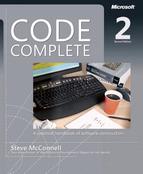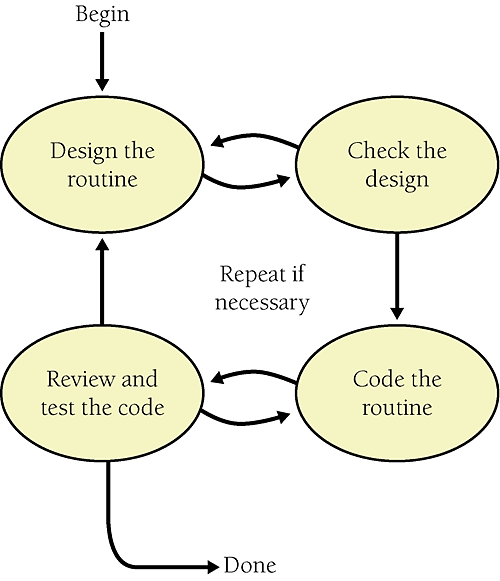Contents
Related Topics
Creating high-quality classes: Chapter 6
Characteristics of high-quality routines: Chapter 7
Design in Construction: Chapter 5
Commenting style: Chapter 32
Although you could view this whole book as an extended description of the programming process for creating classes and routines, this chapter puts the steps in context. This chapter focuses on programming in the small—on the specific steps for building an individual class and its routines, the steps that are critical on projects of all sizes. The chapter also describes the Pseudocode Programming Process (PPP), which reduces the work required during design and documentation and improves the quality of both.
If you're an expert programmer, you might just skim this chapter, but look at the summary of steps and review the tips for constructing routines using the Pseudocode Programming Process in Constructing Routines by Using the PPP. Few programmers exploit the full power of the process, and it offers many benefits.
The PPP is not the only procedure for creating classes and routines. Alternatives to the PPP, at the end of this chapter, describes the most popular alternatives, including test-first development and design by contract.
Class construction can be approached from numerous directions, but usually it's an iterative process of creating a general design for the class, enumerating specific routines within the class, constructing specific routines, and checking class construction as a whole. As Figure 9-1 suggests, class creation can be a messy process for all the reasons that design is a messy process (reasons that are described in Design Challenges).
Figure 9-1. Details of class construction vary, but the activities generally occur in the order shown here
The key steps in constructing a class are:
Create a general design for the class. Class design includes numerous specific issues. Define the class's specific responsibilities, define what "secrets" the class will hide, and define exactly what abstraction the class interface will capture. Determine whether the class will be derived from another class and whether other classes will be allowed to derive from it. Identify the class's key public methods, and identify and design any nontrivial data members used by the class. Iterate through these topics as many times as needed to create a straightforward design for the routine. These considerations and many others are discussed in more detail in Chapter 6.
Construct each routine within the class. Once you've identified the class's major routines in the first step, you must construct each specific routine. Construction of each routine typically unearths the need for additional routines, both minor and major, and issues arising from creating those additional routines often ripple back to the overall class design.
Review and test the class as a whole. Normally, each routine is tested as it's created. After the class as a whole becomes operational, the class as a whole should be reviewed and tested for any issues that can't be tested at the individual-routine level.
Many of a class's routines will be simple and straightforward to implement: accessor routines, pass-throughs to other objects' routines, and the like. Implementation of other routines will be more complicated, and creation of those routines benefits from a systematic approach. The major activities involved in creating a routine—designing the routine, checking the design, coding the routine, and checking the code—are typically performed in the order shown in Figure 9-2.
Figure 9-2. These are the major activities that go into constructing a routine. They're usually performed in the order shown
Experts have developed numerous approaches to creating routines, and my favorite approach is the Pseudocode Programming Process, described in the next section.


